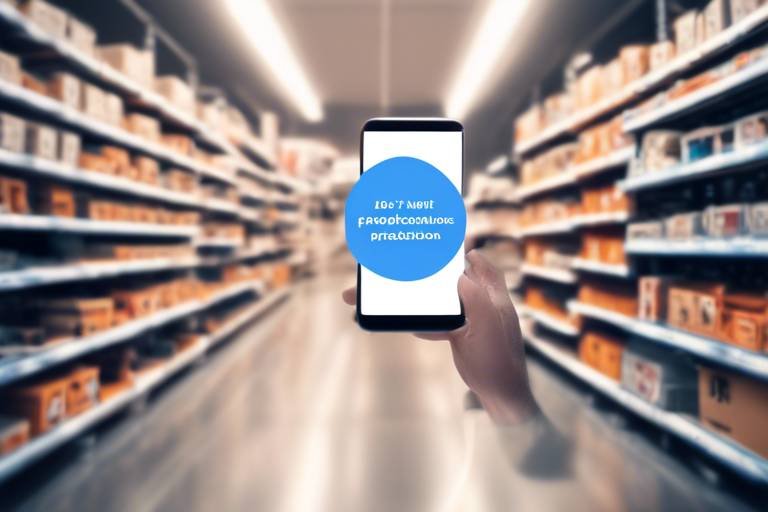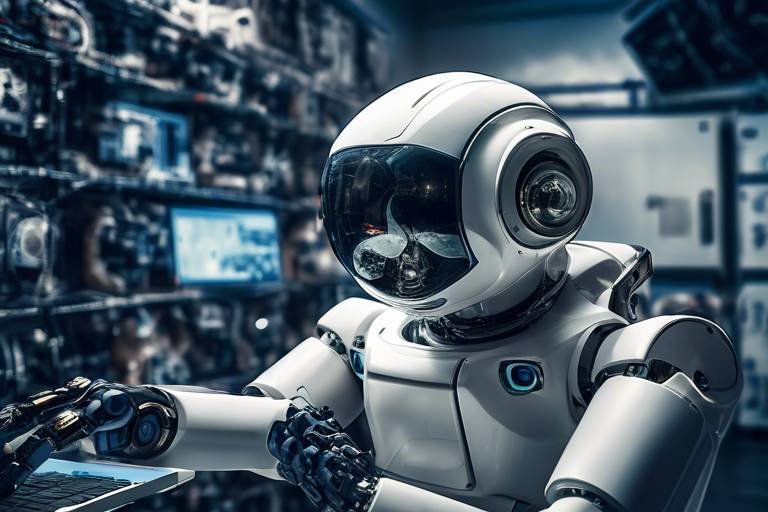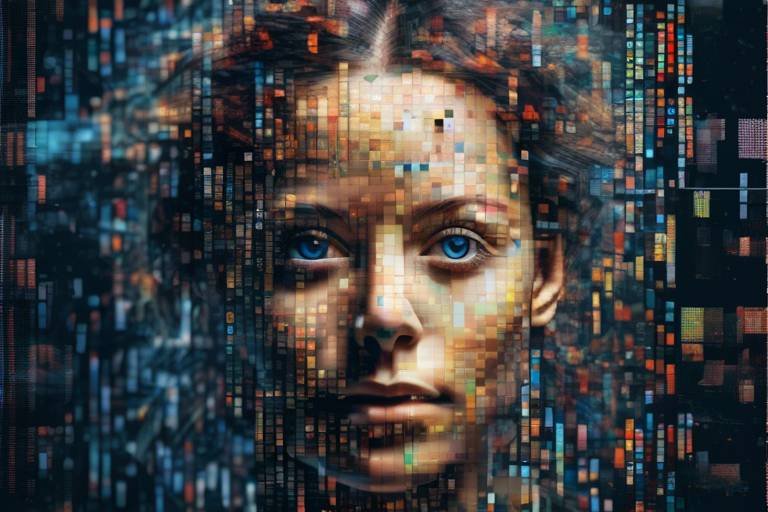The Future of Design: AI and Machine Learning
The design industry is undergoing a dramatic transformation, and at the heart of this evolution are artificial intelligence (AI) and machine learning. These technologies are not just buzzwords; they are reshaping how we think about creativity and innovation in design. Imagine a world where algorithms can predict trends before they even emerge, where designers can harness the power of data to create personalized experiences, and where AI acts as a collaborative partner rather than a competitor. This is not science fiction—it's happening now!
As we dive deeper into the impact of AI and machine learning on design, it becomes clear that these technologies are enhancing our creative processes in ways we never thought possible. From automating mundane tasks to providing insights that drive strategic thinking, AI is enabling designers to focus on what truly matters: innovation. By leveraging data-driven insights, designers can create solutions that are not only aesthetically pleasing but also deeply aligned with user needs and preferences.
However, this technological revolution is not without its challenges. As we embrace the capabilities of AI, we must also navigate the ethical considerations that come with it. Questions of ownership, bias, and the implications of automated decision-making loom large. It's essential to strike a balance between human creativity and machine efficiency to ensure that the unique vision of the designer is not overshadowed by algorithms.
In the following sections, we will explore the various facets of AI and machine learning in design, including how machine learning algorithms analyze data to identify patterns, the role of predictive analytics in enhancing user experience, and the potential challenges that arise from integrating AI into the creative process. Buckle up, because the future of design is not just bright—it's bursting with possibilities!
AI is revolutionizing the design landscape by automating tasks, enhancing creativity, and providing data-driven insights. This allows designers to focus on innovation and strategic thinking rather than getting bogged down by repetitive tasks. Imagine being able to automate the tedious aspects of design, such as resizing images or generating color palettes, freeing up time to brainstorm innovative concepts. With AI, this is becoming a reality.
Machine learning algorithms are the backbone of this transformation. By analyzing vast datasets, they identify patterns and trends that can inform design decisions. For instance, if a designer is working on a new app, a machine learning algorithm can sift through user data to reveal preferences and behaviors, allowing for more personalized and effective solutions. This means designers can create experiences that resonate with users on a deeper level, making their work not just functional but also profoundly engaging.
One of the most exciting applications of machine learning in design is predictive analytics. This technology allows designers to anticipate user behavior and preferences, enabling them to create proactive solutions that enhance user experience and engagement. For example, a fashion retailer could use predictive analytics to forecast which styles will be popular in the coming season, allowing them to stock their inventory accordingly.
Utilizing data in design leads to informed decisions. Designers can ensure that their choices align with user preferences and market demands, ultimately improving outcomes. This data-driven approach not only enhances creativity but also provides a competitive edge in a crowded marketplace. By understanding what users want and need, designers can create products that not only look good but also function seamlessly.
AI-driven personalization allows for tailored experiences, enabling designers to create unique products or services that resonate with individual users. Imagine walking into a website that recognizes your preferences and suggests products just for you. This level of customization is becoming increasingly feasible with AI, making the user experience more engaging and personal.
AI tools are becoming collaborative partners for designers, offering inspiration and generating ideas. This expands the creative possibilities within the design process. Rather than replacing human creativity, AI enhances it, providing designers with new perspectives and insights that can lead to groundbreaking ideas. Think of AI as a brainstorming buddy that never runs out of ideas!
Despite its advantages, integrating AI in design presents challenges. Ethical considerations, the need for human oversight, and potential job displacement concerns are all important issues that must be addressed. As we navigate this new landscape, it’s crucial to ensure that AI complements rather than replaces the unique vision of the designer.
The use of AI in design raises ethical questions regarding ownership, bias, and the implications of automated decision-making on creative integrity. As designers, we must be vigilant in ensuring that our work remains authentic and that we are not inadvertently perpetuating biases present in the data we use.
Finding the right balance between human creativity and machine efficiency is essential. AI should enhance our creative processes, not overshadow them. By maintaining this balance, we can harness the full potential of AI while preserving the unique human touch that defines great design.
- What is AI's role in design? AI automates tasks, enhances creativity, and provides data-driven insights to improve design processes.
- How does machine learning benefit designers? Machine learning analyzes data to identify trends and user preferences, helping designers create personalized solutions.
- What are the ethical concerns of using AI in design? Ethical concerns include ownership, bias, and the impact of automated decision-making on creative integrity.
- Can AI replace human designers? No, AI should complement human creativity, not replace it. The unique vision of designers remains irreplaceable.

The Role of AI in Design
Artificial Intelligence (AI) is not just a buzzword; it’s a game-changer that is revolutionizing the design landscape. Imagine a world where designers can focus on their creative vision while AI handles the mundane tasks. Sounds appealing, right? By automating repetitive processes, AI frees up valuable time, allowing designers to channel their energies into innovation and strategic thinking. This synergy between human creativity and machine efficiency is paving the way for a new era in design.
AI enhances creativity in ways that were once thought impossible. For instance, AI tools can analyze vast amounts of data in real-time, providing designers with insights that can spark new ideas. Picture this: a designer is working on a new app interface. Instead of spending hours sifting through user feedback, AI can quickly summarize user preferences and highlight trends. This not only speeds up the design process but also ensures that the final product resonates with the target audience.
Moreover, AI's ability to provide data-driven insights is a game-changer. By analyzing user interactions and behaviors, AI can suggest design modifications that improve user experience. For example, if a website's bounce rate is high, AI can identify the problematic areas and recommend adjustments. This level of precision allows designers to make informed decisions that align with user needs, ultimately leading to better outcomes.
But how does AI achieve this? Through advanced algorithms and machine learning techniques, AI can identify patterns and trends from the data it processes. These insights can be used to create more personalized and effective design solutions. Imagine a clothing brand that uses AI to analyze customer preferences. The result? A collection that feels tailor-made for each shopper, enhancing their shopping experience and increasing sales.
In this new design landscape, AI isn't just a tool; it’s becoming a collaborative partner. Designers can leverage AI to brainstorm ideas, generate variations of designs, and even predict which concepts will resonate with users. This partnership expands the creative possibilities, allowing designers to explore avenues they might not have considered otherwise.
However, it's essential to remember that while AI can enhance the design process, it should not overshadow the human element. The unique perspective and emotional intelligence that a human designer brings to the table are irreplaceable. AI can assist, but the heart and soul of design still come from human creativity. Striking the right balance between human intuition and machine efficiency will be crucial as we move forward.
In summary, AI's role in design is multifaceted and transformative. From automating tasks to providing data-driven insights and enhancing creativity, AI is reshaping how designers approach their work. As we embrace these advancements, we must also remain vigilant about the ethical implications and ensure that the human touch remains at the forefront of the design process.
- How is AI changing the design industry? AI automates repetitive tasks, enhances creativity, and provides valuable data-driven insights, allowing designers to focus on innovation.
- What are the benefits of using AI in design? AI helps in personalizing user experiences, improving decision-making, and speeding up the design process.
- Can AI replace human designers? While AI can assist and enhance the design process, human creativity and emotional intelligence are irreplaceable.

Machine Learning Algorithms
Machine learning algorithms are the backbone of modern design, acting as the unseen force that drives innovation and personalization. These algorithms are designed to analyze vast datasets, uncovering patterns and trends that would be impossible for humans to detect alone. Imagine having a super-smart assistant that can sift through mountains of data in seconds, identifying what users love and what they don’t. This capability allows designers to create solutions that are not just effective but also deeply resonant with the audience.
At the core of machine learning in design are various algorithms that can be categorized into three main types: supervised learning, unsupervised learning, and reinforcement learning. Each of these has its unique application and benefits:
- Supervised Learning: This involves training a model on a labeled dataset, where the algorithm learns to make predictions based on input-output pairs. For example, a designer could use this method to predict user preferences based on past interactions.
- Unsupervised Learning: Unlike supervised learning, this method deals with unlabeled data. The algorithm identifies hidden patterns without prior knowledge. This is particularly useful for segmenting users into distinct groups based on behavior.
- Reinforcement Learning: This type of learning is akin to training a pet. The algorithm learns by receiving rewards or penalties based on its actions. In design, this could mean optimizing user interfaces by continuously adapting based on user feedback.
These algorithms empower designers to create more personalized and effective solutions. For instance, by analyzing user data, designers can tailor experiences that align with individual preferences. This is not just about aesthetics; it's about creating a meaningful connection between the user and the product. Think of it as crafting a bespoke suit—every stitch and fabric choice is made with the wearer in mind, resulting in a perfect fit.
One of the most exciting applications of machine learning in design is predictive analytics. By harnessing the power of historical data, predictive analytics can anticipate user behavior and preferences. This means designers can proactively create solutions that not only meet current needs but also foresee future demands. For example, an e-commerce site might use predictive analytics to recommend products that a user is likely to purchase based on their browsing history and similar user behaviors. This proactive approach enhances user experience and engagement, making the user feel understood and valued.
Utilizing data in design is no longer a luxury; it's a necessity. Data-driven decision-making ensures that design choices are informed and aligned with user preferences and market demands. By analyzing user feedback, designers can refine their work, ensuring that it resonates with the target audience. This leads to better outcomes, higher user satisfaction, and ultimately, increased loyalty. In a world where choices are abundant, being data-driven helps designers stand out by delivering exactly what users are looking for.
AI-driven personalization is reshaping how products and services are delivered. Imagine walking into a store where every item is tailored to your taste. That’s what AI allows designers to achieve. By leveraging machine learning algorithms, designers can create unique experiences that resonate with individual users. Whether it’s a personalized website layout or a custom product recommendation, the goal is to make each user feel special. This level of customization not only enhances user satisfaction but also fosters a deeper connection between the brand and its audience.

Predictive Analytics in Design
Predictive analytics is like having a crystal ball for designers, allowing them to foresee user behavior and preferences before they even manifest. By leveraging machine learning algorithms, designers can analyze historical data to identify trends and patterns that inform their creative processes. Imagine being able to predict what your users will want before they even know it themselves! This capability not only enhances the user experience but also enables designers to create solutions that are both proactive and engaging.
For instance, when a designer is working on a website, predictive analytics can provide insights into how users typically navigate similar sites. By understanding these behaviors, designers can optimize layouts, streamline navigation, and ultimately create a more intuitive experience. This foresight is invaluable, as it allows designers to make informed decisions that align closely with user expectations and needs.
But how exactly does predictive analytics work in design? It starts with data collection. Designers gather information from various sources, including user interactions, feedback, and market trends. This data is then processed using machine learning algorithms that identify correlations and insights. The result? A comprehensive understanding of user behavior that can be translated into actionable design strategies.
To illustrate this further, let’s take a look at a practical example:
| Data Source | Insights Gained | Design Application |
|---|---|---|
| User Interaction Logs | Common paths users take through a site | Streamlined navigation menus |
| Customer Feedback | Preferred features and functionalities | Enhanced product features |
| Market Trends | Emerging design styles and user preferences | Incorporating trendy aesthetics |
This table highlights how various data sources contribute to the design process, showcasing the power of predictive analytics in shaping user-centric designs. By understanding the insights gained from user interactions, feedback, and market trends, designers can make informed choices that resonate with their audience.
Moreover, predictive analytics not only improves the design process but also fosters a deeper connection between the user and the product. When users feel that a design speaks to their needs and preferences, it enhances their overall experience and increases engagement. This is especially crucial in today's fast-paced digital environment, where user attention is fleeting and competition is fierce.
In conclusion, predictive analytics is transforming the way designers approach their work. By harnessing the power of data, designers can anticipate user needs, create tailored experiences, and ultimately deliver products that stand out in the marketplace. It’s a game-changer that not only boosts creativity but also ensures that design decisions are grounded in real-world insights.
- What is predictive analytics in design?
Predictive analytics in design refers to the use of data analysis techniques to predict user behavior and preferences, helping designers create more effective and user-friendly products. - How does predictive analytics improve user experience?
By anticipating user needs and preferences, predictive analytics allows designers to create solutions that are more aligned with what users want, leading to a more engaging and satisfying experience. - What types of data are used in predictive analytics?
Designers use various data sources, including user interaction logs, customer feedback, and market trends, to gain insights that inform their design decisions. - Can predictive analytics replace human creativity in design?
No, predictive analytics is a tool that enhances human creativity. It provides insights that can inspire designers, but the unique vision and creativity of a designer remain irreplaceable.

Data-Driven Decision Making
In today's fast-paced world, is not just a luxury; it's a necessity. Designers are increasingly relying on data to guide their creative processes, transforming intuition-based decisions into informed choices backed by solid evidence. Imagine walking into a bustling café where every table is filled with customers, and you have to decide which one to approach. Instead of guessing which table might be the most welcoming, you can observe the patterns—like where the laughter is coming from or which table has the most engaged conversations. This is akin to how designers use data to navigate their creative landscape.
By utilizing analytics tools, designers can gather insights from various sources, such as user interactions, market trends, and feedback loops. This wealth of information allows them to understand what resonates with their audience. For instance, a designer working on a mobile app can track user engagement metrics to see which features are most popular, enabling them to prioritize updates and enhancements that truly matter to users. In essence, data becomes the compass that guides the design journey, ensuring that every decision is aligned with user preferences and market demands.
Moreover, the integration of data into the design process fosters a culture of experimentation. Designers can test hypotheses, analyze outcomes, and iterate based on real-world feedback. This is similar to a chef perfecting a recipe; they might add a pinch of salt, taste it, and adjust accordingly based on what their diners enjoy. In the same vein, designers can refine their products by observing how users interact with them, leading to continuous improvement and innovation.
However, data-driven decision making is not without its challenges. One of the key hurdles is ensuring that the data collected is both relevant and accurate. Poor data quality can lead to misguided decisions, ultimately harming the design outcome. Therefore, establishing robust data collection methods and maintaining a keen eye on data integrity is crucial. Additionally, designers must balance quantitative data with qualitative insights, as numbers alone cannot capture the full essence of user experience. It's essential to combine hard data with human stories and emotions to create designs that truly connect with users.
In summary, data-driven decision making is revolutionizing the design industry by enabling designers to make informed choices that enhance user experience and engagement. By leveraging analytics, designers can not only improve their work but also foster a culture of creativity and innovation. As we move forward, embracing data as a core component of the design process will be vital for staying competitive and relevant in an ever-evolving landscape.
- What is data-driven decision making?
Data-driven decision making refers to the practice of using data analysis and metrics to guide business decisions, rather than relying solely on intuition or personal experience. - How can designers collect data?
Designers can collect data through user surveys, analytics tools, A/B testing, and by monitoring user interactions with their products. - Why is data important in design?
Data helps designers understand user preferences, identify trends, and make informed decisions that enhance the overall user experience. - What are the challenges of using data in design?
Challenges include ensuring data quality, balancing quantitative and qualitative insights, and avoiding over-reliance on data at the expense of creativity.

Personalization and Customization
In today's fast-paced digital world, personalization and customization have become more than just buzzwords; they are essential components of effective design strategies. Imagine walking into a store where every product is tailored to your taste, or browsing a website that instantly recognizes your preferences and curates content just for you. This is the power of AI-driven personalization, and it's transforming how designers approach their work.
At its core, personalization is about creating unique experiences that resonate with individual users. With the help of AI, designers can analyze user data—such as browsing habits, purchase history, and demographic information—to develop insights that inform their design choices. This data-driven approach allows for a deeper understanding of what users want and need, leading to more targeted and effective solutions. For instance, an e-commerce platform can utilize AI algorithms to recommend products that align with a user's previous purchases, enhancing the shopping experience and increasing conversion rates.
Customization, on the other hand, empowers users to tailor products or services to fit their specific preferences. Think of a smartphone application that allows users to adjust the interface according to their liking or a clothing brand that offers made-to-measure options. This level of customization not only boosts user satisfaction but also fosters a sense of ownership and connection to the product. As designers, leveraging AI tools can streamline the customization process, enabling real-time adjustments based on user feedback and preferences.
To illustrate the impact of personalization and customization in design, consider the following table:
| Aspect | Personalization | Customization |
|---|---|---|
| Definition | Creating tailored experiences based on user data | Allowing users to modify products or services to their liking |
| Benefits | Increased engagement and satisfaction | Enhanced user ownership and loyalty |
| Examples | Product recommendations, personalized content | Customizable interfaces, made-to-order products |
As we delve deeper into the realms of AI and machine learning, the potential for personalization and customization continues to grow. Designers who embrace these technologies are not only enhancing user experiences but are also driving innovation in their fields. However, it's essential to strike a balance; while AI can provide invaluable insights and streamline processes, the human touch remains irreplaceable. After all, design is not just about functionality—it's about creating emotional connections.
- What is the difference between personalization and customization? Personalization involves tailoring experiences based on user data, while customization allows users to modify products or services to their preferences.
- How can AI improve personalization in design? AI can analyze vast amounts of user data to identify patterns and preferences, enabling designers to create more relevant and engaging experiences.
- Are there any risks associated with AI-driven personalization? Yes, there are potential ethical concerns, such as privacy issues and data security, that need to be addressed when implementing AI in design.

AI-Enhanced Creativity
Imagine walking into a room filled with artists, each one brimming with unique ideas and perspectives. Now, picture a new kind of artist—a digital partner that doesn’t just sit in the corner but actively collaborates with the creatives around it. This is the reality of . As artificial intelligence continues to evolve, it’s becoming a key player in the design process, offering tools that help designers push the boundaries of their imagination.
AI tools are not just about crunching numbers or automating tasks; they are becoming creative collaborators. For instance, platforms like Adobe Sensei use machine learning to analyze design trends and suggest innovative concepts that a designer might not have considered. This technology acts like a muse, providing inspiration and generating ideas that can lead to groundbreaking designs. Think of it as having a brainstorming buddy who never runs out of energy or creativity!
Furthermore, AI can analyze vast amounts of visual data to identify what works and what doesn’t in design. By examining patterns across different styles, colors, and layouts, AI can recommend adjustments that enhance the overall aesthetic and functionality of a project. This process allows designers to focus more on the big picture—the storytelling aspect of their work—while AI takes care of the nitty-gritty details.
One fascinating application of AI in creativity is in the realm of generative design. This is where algorithms create multiple iterations of a design based on specific parameters set by the designer. For example, an architect might input criteria such as materials, budget, and environmental impact, and the AI generates various design options that meet those needs. It’s like having a digital architect that can think outside the box, exploring possibilities that might take a human designer much longer to conceptualize.
However, the integration of AI in the creative process does not mean that human input is rendered obsolete. On the contrary, AI enhances the designer’s capabilities, allowing them to explore new avenues without losing their unique voice. The relationship between human creativity and AI is akin to a duet, where both parties contribute their strengths to create something truly spectacular.
In conclusion, the future of design is not just about AI taking over; it’s about collaboration and enhancement. As we continue to embrace these technologies, designers will find themselves equipped with powerful tools that expand their creative horizons, enabling them to produce work that resonates on a deeper level with audiences. The synergy between human imagination and AI innovation is where the magic happens, and it’s an exciting time to be involved in the design industry!
- How does AI enhance creativity in design?
AI tools assist designers by providing inspiration, generating ideas, and analyzing trends, which allows for more innovative and effective design solutions. - Can AI replace human designers?
No, AI is meant to complement human creativity, not replace it. The collaboration between AI and designers leads to more unique and impactful designs. - What are some examples of AI tools used in design?
Tools like Adobe Sensei and Autodesk's generative design software are popular examples of AI applications that help designers enhance their creative processes. - Are there ethical concerns with using AI in design?
Yes, ethical considerations such as ownership, bias, and the implications of automation in creative fields are important discussions in the industry.

Challenges of AI in Design
As we dive deeper into the world of artificial intelligence (AI) and its impact on design, it’s essential to acknowledge that, while the benefits are substantial, there are several challenges that need careful consideration. The integration of AI into the design process is not without its hurdles, and addressing these challenges is crucial for a harmonious future where technology and creativity coexist. One of the primary concerns revolves around ethical considerations. As AI systems become more sophisticated, questions arise about ownership of designs generated by these systems. Who truly owns the designs created by AI? Is it the designer who input the parameters, the company that owns the AI, or the AI itself? These questions are not merely academic; they have real implications for intellectual property rights and creative integrity.
Moreover, the potential for bias in AI algorithms is another significant challenge. If the data fed into these systems is biased, the outputs will be, too. This can lead to designs that unintentionally reinforce stereotypes or exclude certain user groups. For instance, if an AI tool is trained predominantly on data from a specific demographic, it may produce designs that do not resonate with or cater to a broader audience. Thus, ensuring diversity in training data is paramount to creating inclusive design solutions.
Another challenge is the need for human oversight. While AI can automate many tasks, the human touch remains irreplaceable in the creative process. Designers must remain vigilant, ensuring that AI-generated outputs align with their vision and the needs of their audience. The balance between human creativity and machine efficiency is delicate; if designers rely too heavily on AI, there’s a risk of losing the unique perspectives that make design truly innovative. It's akin to a painter using a brush versus a machine; while the machine can replicate techniques, it lacks the emotional depth that a human artist brings to their work.
Furthermore, the fear of job displacement looms large in discussions about AI in design. Many professionals worry that as AI tools become more capable, their roles may become obsolete. While it's true that some tasks will be automated, it's also important to recognize that AI can enhance human capabilities rather than replace them. Designers can leverage AI to handle repetitive tasks, allowing them to focus on more strategic and creative aspects of their work. This shift could lead to the emergence of new roles that blend design expertise with technology, creating a dynamic landscape in the job market.
To navigate these challenges successfully, the design industry must foster an environment of collaboration and continuous learning. Designers should be encouraged to understand AI tools deeply, not just as users but as collaborators that can enhance their creative processes. This means investing in education and training that empowers designers to harness AI’s potential while remaining aware of its limitations. As we move forward, the conversation around AI in design must include diverse voices and perspectives to ensure that the technology serves all users equitably and ethically.
- What are the main ethical concerns surrounding AI in design? The main ethical concerns include ownership of AI-generated designs, potential biases in AI algorithms, and the implications of automated decision-making on creative integrity.
- Can AI replace human designers? While AI can automate certain tasks, it cannot replace the unique creativity and emotional depth that human designers bring to their work. AI is best viewed as a tool to enhance human creativity.
- How can designers ensure their work remains relevant in an AI-driven landscape? By embracing continuous learning and understanding AI tools, designers can leverage technology to enhance their work while maintaining their unique creative vision.

Ethical Considerations
The rise of artificial intelligence in design brings with it a host of that cannot be ignored. As we embrace this technology, we must ask ourselves: who truly owns the designs created by AI? Is it the designer who inputs the data, the company that owns the AI, or the AI itself? These questions challenge our traditional notions of copyright and intellectual property, raising concerns about the very essence of creativity.
Moreover, the potential for bias in AI algorithms poses another significant ethical dilemma. If the data fed into these systems is biased, the outputs will inevitably reflect those biases, leading to designs that may not be inclusive or representative of diverse user groups. This is particularly troubling in industries where design impacts daily life, such as fashion, architecture, and product development. Designers must remain vigilant and ensure that the data they use is comprehensive and equitable.
Additionally, the implications of automated decision-making in design can undermine the creative integrity that has long been a hallmark of the profession. When machines begin to dictate design choices, there is a risk that the unique human touch—our emotions, experiences, and perspectives—could be lost in the process. This raises the question: can a machine truly understand the nuances of human experience? The answer remains complex and requires ongoing dialogue within the design community.
To navigate these ethical waters, it is essential for designers and technologists to work together, establishing guidelines that prioritize ethical practices in AI development. This includes:
- Ensuring transparency in AI algorithms and the data used.
- Encouraging diverse teams to mitigate bias in design outputs.
- Maintaining human oversight in decision-making processes to preserve creative integrity.
In conclusion, as we harness the power of AI in design, we must remain mindful of the ethical implications that accompany these advancements. By fostering a culture of responsibility and accountability, we can ensure that technology serves to enhance, rather than diminish, the human experience in design.
Q: What are the main ethical concerns surrounding AI in design?
A: The primary ethical concerns include ownership of AI-generated designs, potential biases in algorithms, and the impact of automated decision-making on creative integrity.
Q: How can designers mitigate bias in AI-generated designs?
A: Designers can mitigate bias by ensuring diverse teams are involved in the design process, using comprehensive datasets, and regularly auditing AI outputs for fairness and inclusivity.
Q: Is AI likely to replace human designers?
A: While AI can enhance and automate certain tasks, it is unlikely to replace human designers entirely. The unique human touch and emotional understanding remain essential in the creative process.

Balancing Human and Machine Collaboration
In the rapidly evolving world of design, the integration of artificial intelligence (AI) is not just a trend; it’s a fundamental shift that requires careful navigation. As designers, we often find ourselves at the crossroads of creativity and technology, where the challenge lies in striking the right balance between human intuition and machine efficiency. Think of it like a dance; while AI can lead with its data-driven insights and predictive capabilities, it’s the human designer who brings emotion, context, and a unique perspective to the performance.
One of the key aspects of achieving this balance is understanding the strengths and limitations of both parties. AI excels at processing vast amounts of data, identifying patterns, and generating options based on established criteria. However, it lacks the emotional intelligence and nuanced understanding of human experiences that a designer possesses. This is where collaboration becomes essential. By leveraging AI as a tool rather than a replacement, designers can enhance their creative processes. For instance, AI can suggest color palettes, generate design variations, or even provide insights on user behavior, allowing designers to focus on the more intricate aspects of their work.
To illustrate this point, consider a scenario where a designer is tasked with creating a new app interface. An AI tool could analyze user data to suggest the most effective layout based on previous interactions. Yet, it’s the designer’s role to interpret that data through the lens of user emotions and brand identity. This collaboration can lead to designs that are not only functional but also resonate deeply with users. Here’s a simple breakdown:
| AI Capabilities | Designer Strengths |
|---|---|
| Data analysis and pattern recognition | Emotional intelligence and creativity |
| Generating design options | Contextual understanding and storytelling |
| Predictive analytics | User empathy and aesthetic judgment |
However, this harmonious relationship doesn’t come without its challenges. Designers must remain vigilant about the potential pitfalls of over-reliance on AI. For example, if designers lean too heavily on automated systems, there’s a risk of losing the personal touch that makes a design truly special. It’s crucial to maintain a human element in the creative process. Regularly questioning the outputs generated by AI and ensuring that human creativity is at the forefront can help mitigate this risk.
Moreover, fostering a culture of collaboration between human designers and AI tools can lead to innovative breakthroughs. Encouraging designers to experiment with AI-generated ideas can spark new directions in their work. By embracing this synergy, we can not only enhance our designs but also push the boundaries of what’s possible in the creative realm.
Ultimately, the goal is not to choose between human creativity and machine efficiency but to blend them into a cohesive workflow. This balance will allow designers to harness the best of both worlds, leading to more innovative, impactful, and user-centric designs. As we continue to explore the possibilities of AI in design, let’s remember that the heart of creativity lies in our human experiences and insights.
- What are the main benefits of using AI in design? AI can automate repetitive tasks, provide data-driven insights, and enhance creativity by generating new ideas.
- How can designers ensure that AI complements their work? By using AI as a tool for inspiration and efficiency, while maintaining their unique vision and emotional intelligence in the design process.
- What challenges do designers face when integrating AI? Ethical considerations, potential job displacement, and the risk of losing the human touch in creativity are some of the challenges.
- Can AI replace human designers? No, while AI can assist and enhance the design process, it cannot replicate the emotional and contextual understanding that human designers bring.
Frequently Asked Questions
- How is AI changing the design industry?
AI is transforming the design industry by automating repetitive tasks, enhancing creativity through innovative tools, and providing insightful data analysis. This allows designers to focus more on strategic thinking and creativity rather than mundane tasks.
- What are machine learning algorithms, and how do they benefit designers?
Machine learning algorithms analyze large datasets to uncover patterns and trends, helping designers create personalized solutions that cater to user preferences. By leveraging these insights, designers can enhance user experience and engagement effectively.
- What is predictive analytics in design?
Predictive analytics uses machine learning to forecast user behavior, enabling designers to develop proactive solutions that improve user interaction and satisfaction. It’s like having a crystal ball that tells you what users might want before they even ask for it!
- How does data-driven decision-making impact design?
Data-driven decision-making ensures that design choices are informed by real user preferences and market trends. This approach leads to better outcomes, as designers can align their work with what users actually want, rather than relying on guesswork.
- Can AI really enhance creativity in design?
Absolutely! AI tools can serve as collaborative partners for designers, offering inspiration and generating creative ideas. They expand the possibilities within the design process, making it easier for designers to explore new concepts and push boundaries.
- What challenges does AI present in the design field?
While AI offers numerous advantages, it also raises challenges such as ethical considerations regarding ownership and bias, the necessity for human oversight, and concerns about potential job displacement. It’s essential to navigate these issues thoughtfully.
- What are the ethical considerations of using AI in design?
The use of AI in design brings up important ethical questions, including issues of ownership of AI-generated content, the risk of bias in algorithms, and the effects of automated decision-making on the integrity of creative work.
- How can designers balance human creativity with AI efficiency?
Finding the right balance involves ensuring that AI complements human creativity rather than replacing it. Designers should leverage AI tools to enhance their unique vision while maintaining oversight and control over the creative process.



















